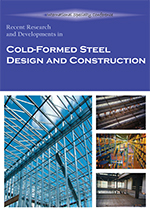Session Dates
24 Aug 2012 - 25 Aug 2012
Abstract
Permanent stability bracing of Cold-Formed Steel (CFS) roof/floor trusses is needed for the three major planes in a truss: Top chord, Bottom Chord and Web. Primary function of bracing is to prevent lateral instability of members as well as stiffen the overall roof/floor system. Brace force is dependent on the magnitude of applied loads and the level of out-of-planeness permitted. Traditionally, 2% of the axial compression force in a member is used as the brace (restraint) force, which is based on an out-of-plane deflection of L/200 where L is the member length. Continuous Lateral Restraint (CLR) forces are accumulated from similar members in several adjacent trusses and then transferred through Diagonal Braces (DB) to the bearings or other shear resisting elements (for example, metal decking). For chord and web members, a method to determine the forces in CLR and DB is presented using a statics based approach with varying number of braces and mode shapes for a maximum permitted out-of-planeness of L/200. For the chord members with more than two CLR's, a method for designing a Brace Collector Frame (BCF) based on the Net Lateral Restraining Force (NLRF) is presented.
Department(s)
Civil, Architectural and Environmental Engineering
Research Center/Lab(s)
Wei-Wen Yu Center for Cold-Formed Steel Structures
Meeting Name
21st International Specialty Conference on Cold-Formed Steel Structures
Publisher
Missouri University of Science and Technology
Document Version
Final Version
Rights
© 2012 Missouri University of Science and Technology, All rights reserved.
Document Type
Article - Conference proceedings
File Type
text
Language
English
Recommended Citation
Rajan, Sowri and Babich, William L., "Permanent Stability Bracing of CFS Trusses" (2012). CCFSS Proceedings of International Specialty Conference on Cold-Formed Steel Structures (1971 - 2018). 5.
https://scholarsmine.mst.edu/isccss/21iccfss/21iccfss-session8/5
Permanent Stability Bracing of CFS Trusses
Permanent stability bracing of Cold-Formed Steel (CFS) roof/floor trusses is needed for the three major planes in a truss: Top chord, Bottom Chord and Web. Primary function of bracing is to prevent lateral instability of members as well as stiffen the overall roof/floor system. Brace force is dependent on the magnitude of applied loads and the level of out-of-planeness permitted. Traditionally, 2% of the axial compression force in a member is used as the brace (restraint) force, which is based on an out-of-plane deflection of L/200 where L is the member length. Continuous Lateral Restraint (CLR) forces are accumulated from similar members in several adjacent trusses and then transferred through Diagonal Braces (DB) to the bearings or other shear resisting elements (for example, metal decking). For chord and web members, a method to determine the forces in CLR and DB is presented using a statics based approach with varying number of braces and mode shapes for a maximum permitted out-of-planeness of L/200. For the chord members with more than two CLR's, a method for designing a Brace Collector Frame (BCF) based on the Net Lateral Restraining Force (NLRF) is presented.



